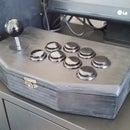Introduction: Etching Glass With a Rotary Tool
Decided to make this tutorial about etching glass with a rotary tool. Had no idea how it would work out but I'm quite pleased with the result. Usually I work with wood so figured this would be a nice project for Beyond the Comfort Zone contest since I haven't had any experience in working with glass.
Step 1:
You will need a printer to print out your designs which you will later trace on the glass. My friend made these in Photoshop with a 10 degree curve so they would end up straight when transferred to glass. You can just print out anything and trace it but then your lines will look a bit crooked on the glass because of the curvature.
Other stuff you need is a pair of scissors, masking tape, rotary tool and diamond tip bits. I bought my bit set for 5$ on ebay.
Step 2:
Cut out your picture and place it in a glass. Secure it with masking tape so it doesn't move.
Step 3:
Securely grip the glass in your hand. Grab the rotary tool like a pen and start tracing the image. Sadly I couldn't take a picture of how I'm actually holding both the glass and the tool but it should be fairly simple to understand by looking at the pics.
Step 4:
Outlines traced and paper inside removed. You can opt to finish at this point.
Step 5:
Filling the insides of the trace. I found that having a dark background makes it much more easy to see what you're doing.
Hope you like the tutorial and have fun etching!

Third Prize in the
Beyond the Comfort Zone Contest













